Annual Integrated Marketing Communication Plan for Food.com
VerifiedAdded on 2022/08/12
|8
|1397
|13
Report
AI Summary
This report develops an integrated communication plan for Food.com, a company offering food products and services. It begins with a case study introduction, outlining the company's mission to introduce innovative food products and secure revenue. The report then applies the AIDA model, setting SMART objectives for each stage (Attention, Interest, Desire, Action) and detailing corresponding strategies. It establishes goals and objectives for Food.com, aiming for increased sales revenue and market share. The plan includes action plans such as social media marketing, advertising, and increasing online presence, with associated KPIs (sales revenue, website traffic, customer engagement). A schedule and budget are provided, detailing activities, responsible departments, and costs. The report concludes with expected results, including increased sales, customer engagement, and brand loyalty through online and offline promotions.

Running head: SALES PLANNING
SALES PLANNING
Student’s Name
University Name
Author note
SALES PLANNING
Student’s Name
University Name
Author note
Paraphrase This Document
Need a fresh take? Get an instant paraphrase of this document with our AI Paraphraser
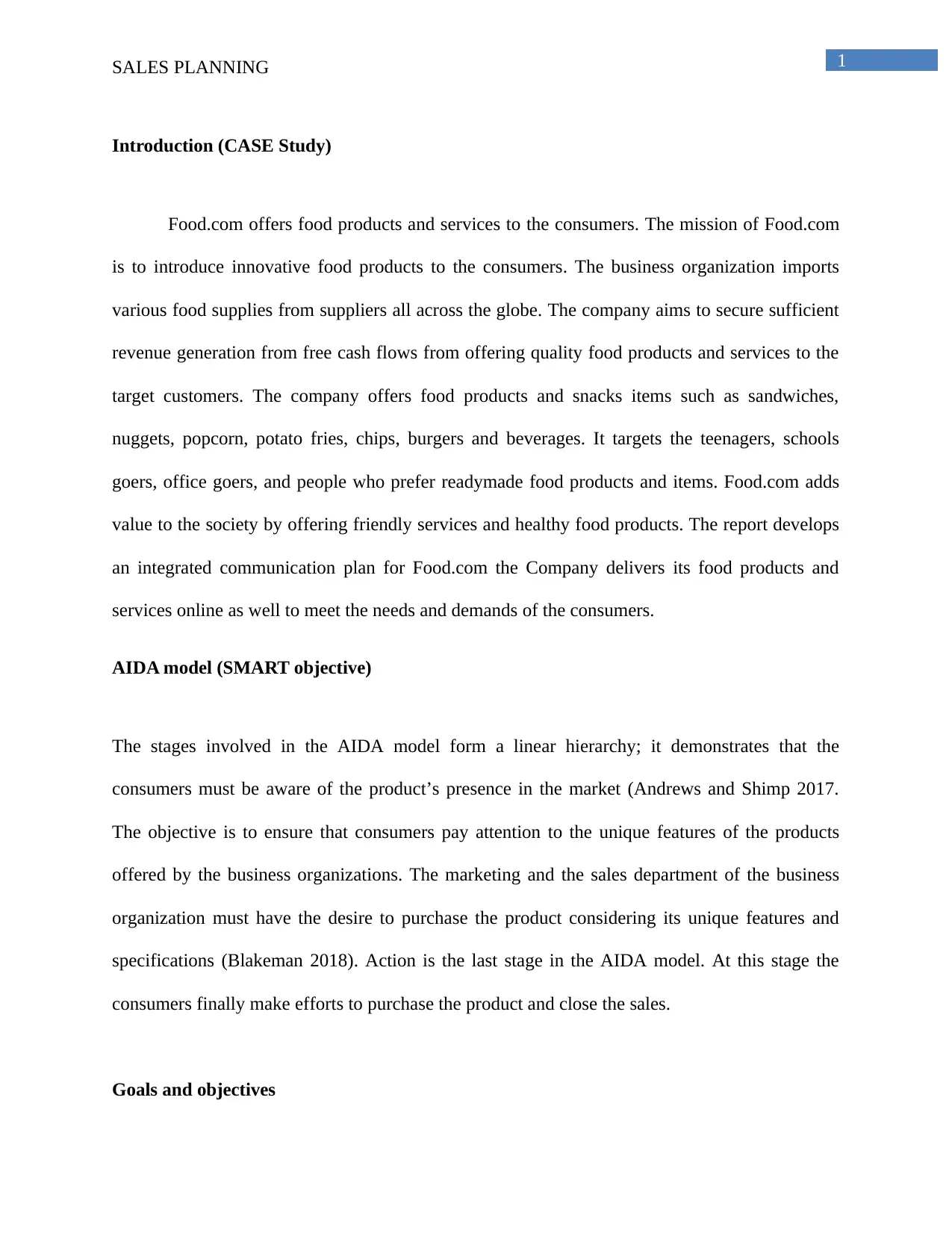
1SALES PLANNING
Introduction (CASE Study)
Food.com offers food products and services to the consumers. The mission of Food.com
is to introduce innovative food products to the consumers. The business organization imports
various food supplies from suppliers all across the globe. The company aims to secure sufficient
revenue generation from free cash flows from offering quality food products and services to the
target customers. The company offers food products and snacks items such as sandwiches,
nuggets, popcorn, potato fries, chips, burgers and beverages. It targets the teenagers, schools
goers, office goers, and people who prefer readymade food products and items. Food.com adds
value to the society by offering friendly services and healthy food products. The report develops
an integrated communication plan for Food.com the Company delivers its food products and
services online as well to meet the needs and demands of the consumers.
AIDA model (SMART objective)
The stages involved in the AIDA model form a linear hierarchy; it demonstrates that the
consumers must be aware of the product’s presence in the market (Andrews and Shimp 2017.
The objective is to ensure that consumers pay attention to the unique features of the products
offered by the business organizations. The marketing and the sales department of the business
organization must have the desire to purchase the product considering its unique features and
specifications (Blakeman 2018). Action is the last stage in the AIDA model. At this stage the
consumers finally make efforts to purchase the product and close the sales.
Goals and objectives
Introduction (CASE Study)
Food.com offers food products and services to the consumers. The mission of Food.com
is to introduce innovative food products to the consumers. The business organization imports
various food supplies from suppliers all across the globe. The company aims to secure sufficient
revenue generation from free cash flows from offering quality food products and services to the
target customers. The company offers food products and snacks items such as sandwiches,
nuggets, popcorn, potato fries, chips, burgers and beverages. It targets the teenagers, schools
goers, office goers, and people who prefer readymade food products and items. Food.com adds
value to the society by offering friendly services and healthy food products. The report develops
an integrated communication plan for Food.com the Company delivers its food products and
services online as well to meet the needs and demands of the consumers.
AIDA model (SMART objective)
The stages involved in the AIDA model form a linear hierarchy; it demonstrates that the
consumers must be aware of the product’s presence in the market (Andrews and Shimp 2017.
The objective is to ensure that consumers pay attention to the unique features of the products
offered by the business organizations. The marketing and the sales department of the business
organization must have the desire to purchase the product considering its unique features and
specifications (Blakeman 2018). Action is the last stage in the AIDA model. At this stage the
consumers finally make efforts to purchase the product and close the sales.
Goals and objectives
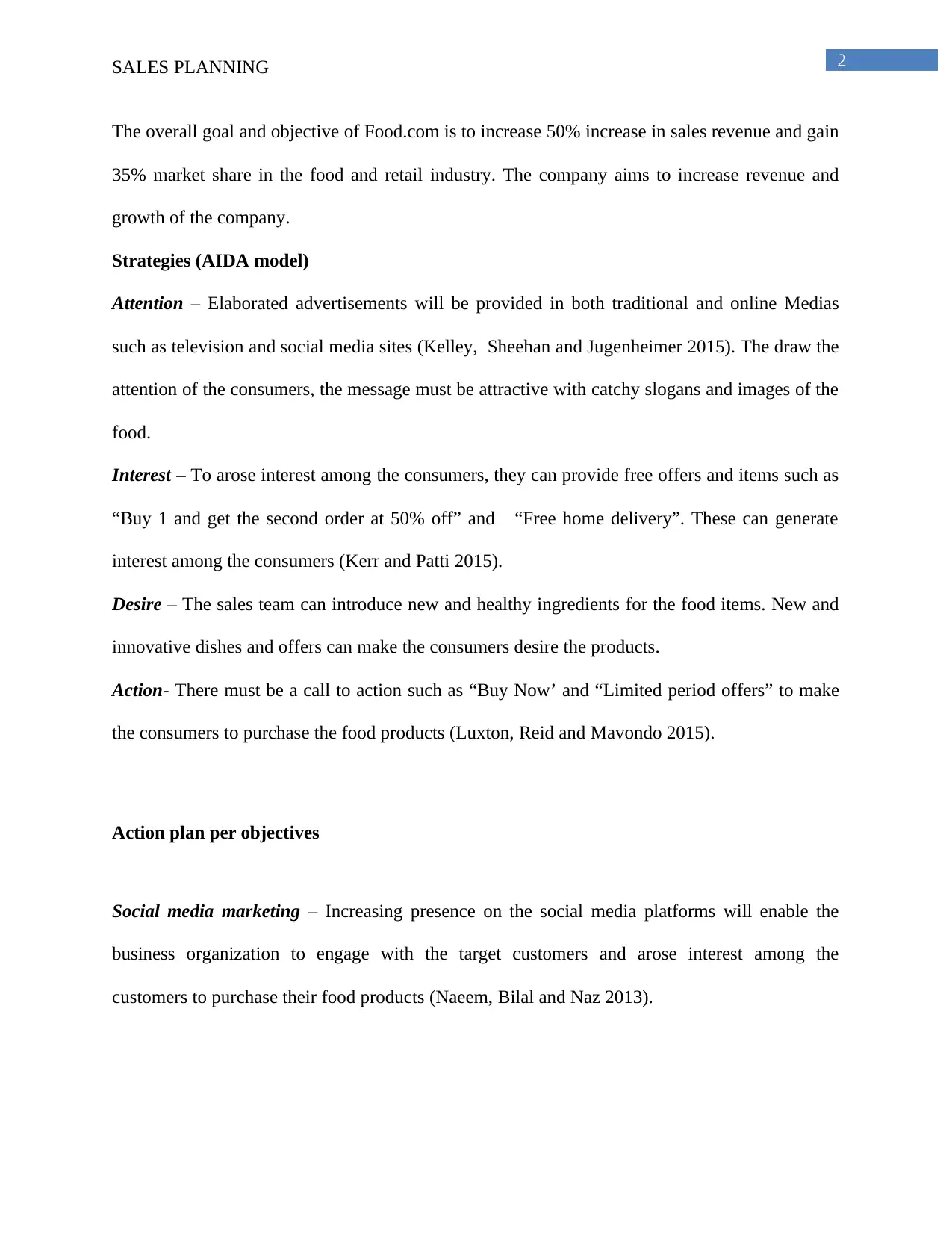
2SALES PLANNING
The overall goal and objective of Food.com is to increase 50% increase in sales revenue and gain
35% market share in the food and retail industry. The company aims to increase revenue and
growth of the company.
Strategies (AIDA model)
Attention – Elaborated advertisements will be provided in both traditional and online Medias
such as television and social media sites (Kelley, Sheehan and Jugenheimer 2015). The draw the
attention of the consumers, the message must be attractive with catchy slogans and images of the
food.
Interest – To arose interest among the consumers, they can provide free offers and items such as
“Buy 1 and get the second order at 50% off” and “Free home delivery”. These can generate
interest among the consumers (Kerr and Patti 2015).
Desire – The sales team can introduce new and healthy ingredients for the food items. New and
innovative dishes and offers can make the consumers desire the products.
Action- There must be a call to action such as “Buy Now’ and “Limited period offers” to make
the consumers to purchase the food products (Luxton, Reid and Mavondo 2015).
Action plan per objectives
Social media marketing – Increasing presence on the social media platforms will enable the
business organization to engage with the target customers and arose interest among the
customers to purchase their food products (Naeem, Bilal and Naz 2013).
The overall goal and objective of Food.com is to increase 50% increase in sales revenue and gain
35% market share in the food and retail industry. The company aims to increase revenue and
growth of the company.
Strategies (AIDA model)
Attention – Elaborated advertisements will be provided in both traditional and online Medias
such as television and social media sites (Kelley, Sheehan and Jugenheimer 2015). The draw the
attention of the consumers, the message must be attractive with catchy slogans and images of the
food.
Interest – To arose interest among the consumers, they can provide free offers and items such as
“Buy 1 and get the second order at 50% off” and “Free home delivery”. These can generate
interest among the consumers (Kerr and Patti 2015).
Desire – The sales team can introduce new and healthy ingredients for the food items. New and
innovative dishes and offers can make the consumers desire the products.
Action- There must be a call to action such as “Buy Now’ and “Limited period offers” to make
the consumers to purchase the food products (Luxton, Reid and Mavondo 2015).
Action plan per objectives
Social media marketing – Increasing presence on the social media platforms will enable the
business organization to engage with the target customers and arose interest among the
customers to purchase their food products (Naeem, Bilal and Naz 2013).
⊘ This is a preview!⊘
Do you want full access?
Subscribe today to unlock all pages.

Trusted by 1+ million students worldwide
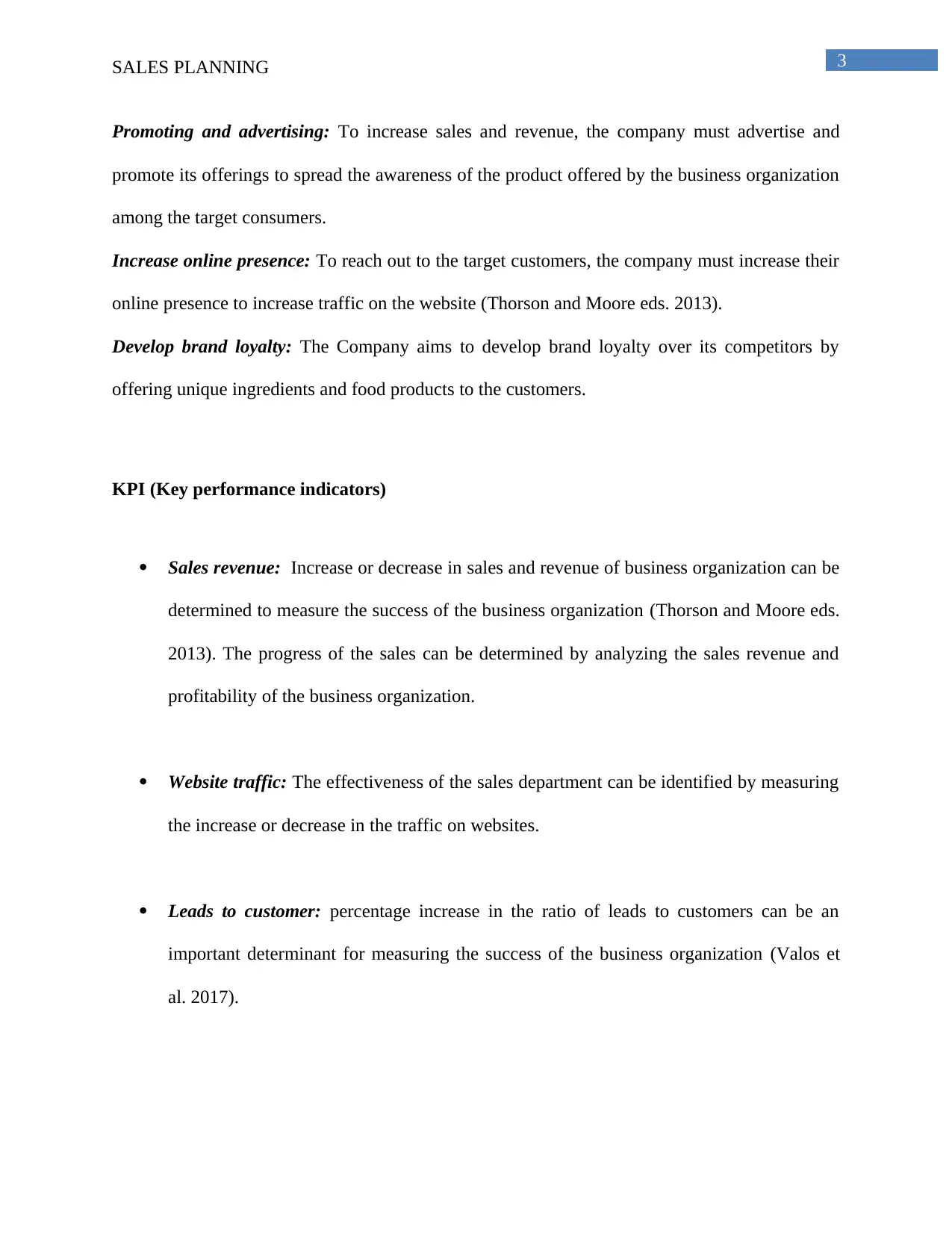
3SALES PLANNING
Promoting and advertising: To increase sales and revenue, the company must advertise and
promote its offerings to spread the awareness of the product offered by the business organization
among the target consumers.
Increase online presence: To reach out to the target customers, the company must increase their
online presence to increase traffic on the website (Thorson and Moore eds. 2013).
Develop brand loyalty: The Company aims to develop brand loyalty over its competitors by
offering unique ingredients and food products to the customers.
KPI (Key performance indicators)
Sales revenue: Increase or decrease in sales and revenue of business organization can be
determined to measure the success of the business organization (Thorson and Moore eds.
2013). The progress of the sales can be determined by analyzing the sales revenue and
profitability of the business organization.
Website traffic: The effectiveness of the sales department can be identified by measuring
the increase or decrease in the traffic on websites.
Leads to customer: percentage increase in the ratio of leads to customers can be an
important determinant for measuring the success of the business organization (Valos et
al. 2017).
Promoting and advertising: To increase sales and revenue, the company must advertise and
promote its offerings to spread the awareness of the product offered by the business organization
among the target consumers.
Increase online presence: To reach out to the target customers, the company must increase their
online presence to increase traffic on the website (Thorson and Moore eds. 2013).
Develop brand loyalty: The Company aims to develop brand loyalty over its competitors by
offering unique ingredients and food products to the customers.
KPI (Key performance indicators)
Sales revenue: Increase or decrease in sales and revenue of business organization can be
determined to measure the success of the business organization (Thorson and Moore eds.
2013). The progress of the sales can be determined by analyzing the sales revenue and
profitability of the business organization.
Website traffic: The effectiveness of the sales department can be identified by measuring
the increase or decrease in the traffic on websites.
Leads to customer: percentage increase in the ratio of leads to customers can be an
important determinant for measuring the success of the business organization (Valos et
al. 2017).
Paraphrase This Document
Need a fresh take? Get an instant paraphrase of this document with our AI Paraphraser
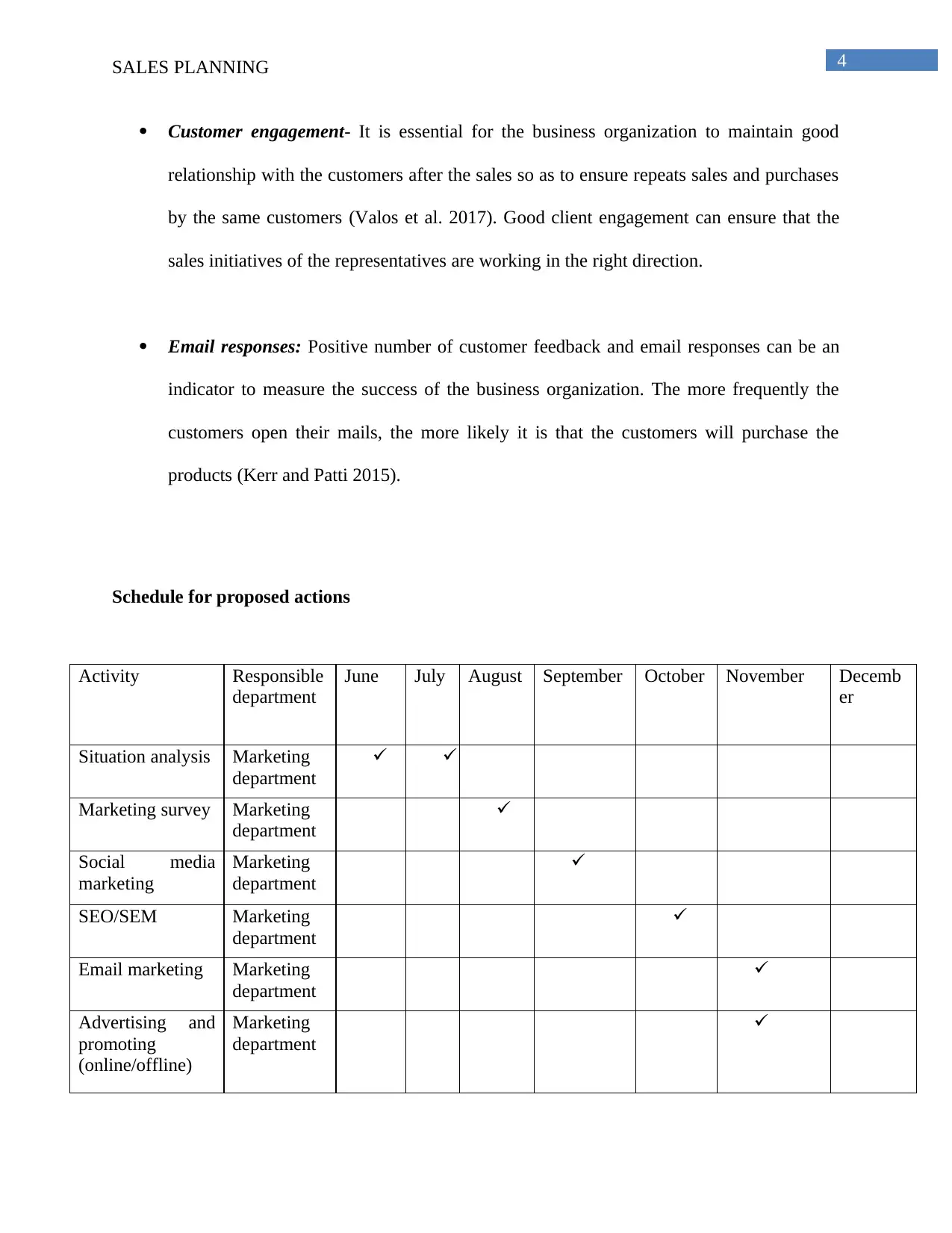
4SALES PLANNING
Customer engagement- It is essential for the business organization to maintain good
relationship with the customers after the sales so as to ensure repeats sales and purchases
by the same customers (Valos et al. 2017). Good client engagement can ensure that the
sales initiatives of the representatives are working in the right direction.
Email responses: Positive number of customer feedback and email responses can be an
indicator to measure the success of the business organization. The more frequently the
customers open their mails, the more likely it is that the customers will purchase the
products (Kerr and Patti 2015).
Schedule for proposed actions
Activity Responsible
department
June July August September October November Decemb
er
Situation analysis Marketing
department
Marketing survey Marketing
department
Social media
marketing
Marketing
department
SEO/SEM Marketing
department
Email marketing Marketing
department
Advertising and
promoting
(online/offline)
Marketing
department
Customer engagement- It is essential for the business organization to maintain good
relationship with the customers after the sales so as to ensure repeats sales and purchases
by the same customers (Valos et al. 2017). Good client engagement can ensure that the
sales initiatives of the representatives are working in the right direction.
Email responses: Positive number of customer feedback and email responses can be an
indicator to measure the success of the business organization. The more frequently the
customers open their mails, the more likely it is that the customers will purchase the
products (Kerr and Patti 2015).
Schedule for proposed actions
Activity Responsible
department
June July August September October November Decemb
er
Situation analysis Marketing
department
Marketing survey Marketing
department
Social media
marketing
Marketing
department
SEO/SEM Marketing
department
Email marketing Marketing
department
Advertising and
promoting
(online/offline)
Marketing
department
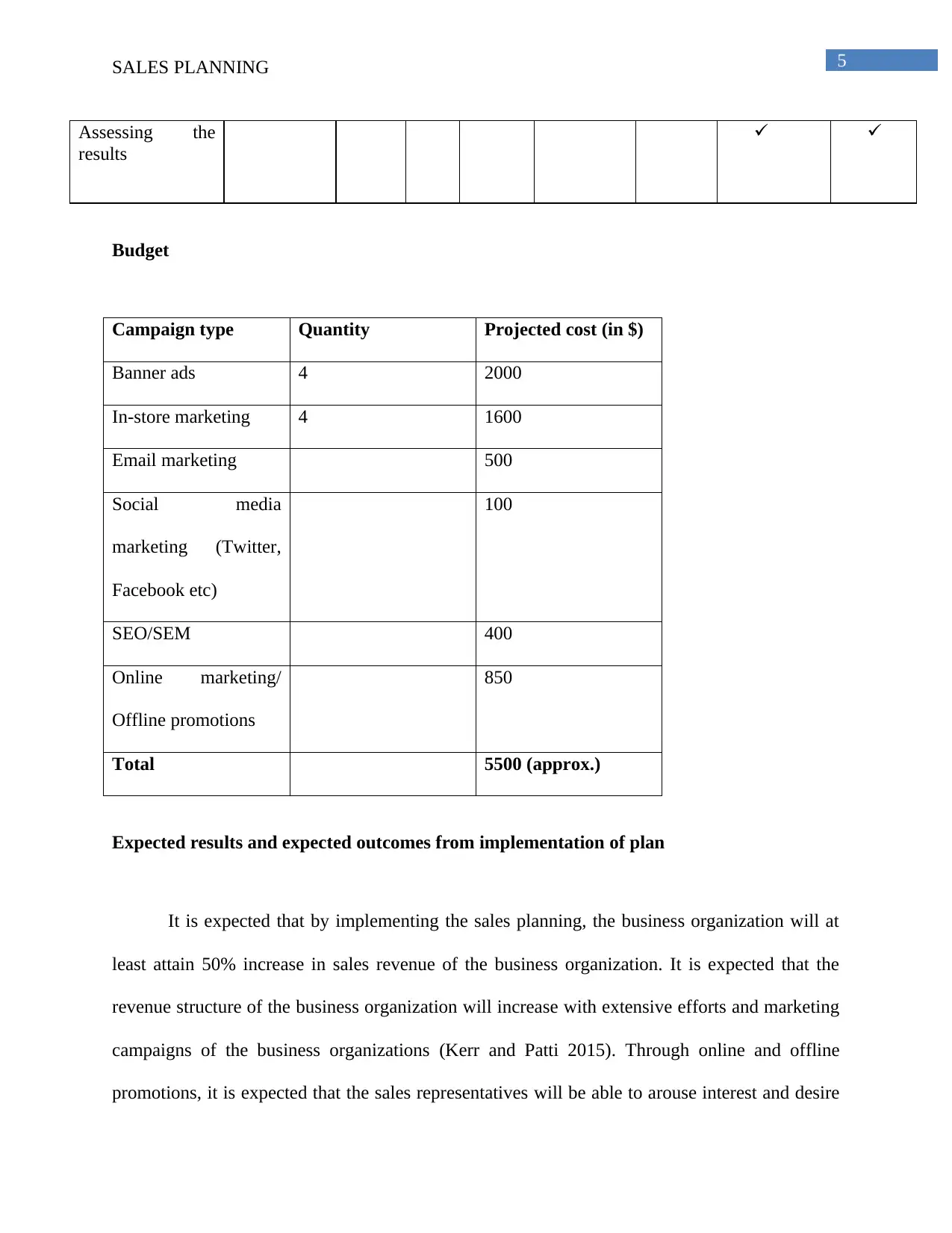
5SALES PLANNING
Assessing the
results
Budget
Campaign type Quantity Projected cost (in $)
Banner ads 4 2000
In-store marketing 4 1600
Email marketing 500
Social media
marketing (Twitter,
Facebook etc)
100
SEO/SEM 400
Online marketing/
Offline promotions
850
Total 5500 (approx.)
Expected results and expected outcomes from implementation of plan
It is expected that by implementing the sales planning, the business organization will at
least attain 50% increase in sales revenue of the business organization. It is expected that the
revenue structure of the business organization will increase with extensive efforts and marketing
campaigns of the business organizations (Kerr and Patti 2015). Through online and offline
promotions, it is expected that the sales representatives will be able to arouse interest and desire
Assessing the
results
Budget
Campaign type Quantity Projected cost (in $)
Banner ads 4 2000
In-store marketing 4 1600
Email marketing 500
Social media
marketing (Twitter,
Facebook etc)
100
SEO/SEM 400
Online marketing/
Offline promotions
850
Total 5500 (approx.)
Expected results and expected outcomes from implementation of plan
It is expected that by implementing the sales planning, the business organization will at
least attain 50% increase in sales revenue of the business organization. It is expected that the
revenue structure of the business organization will increase with extensive efforts and marketing
campaigns of the business organizations (Kerr and Patti 2015). Through online and offline
promotions, it is expected that the sales representatives will be able to arouse interest and desire
⊘ This is a preview!⊘
Do you want full access?
Subscribe today to unlock all pages.

Trusted by 1+ million students worldwide
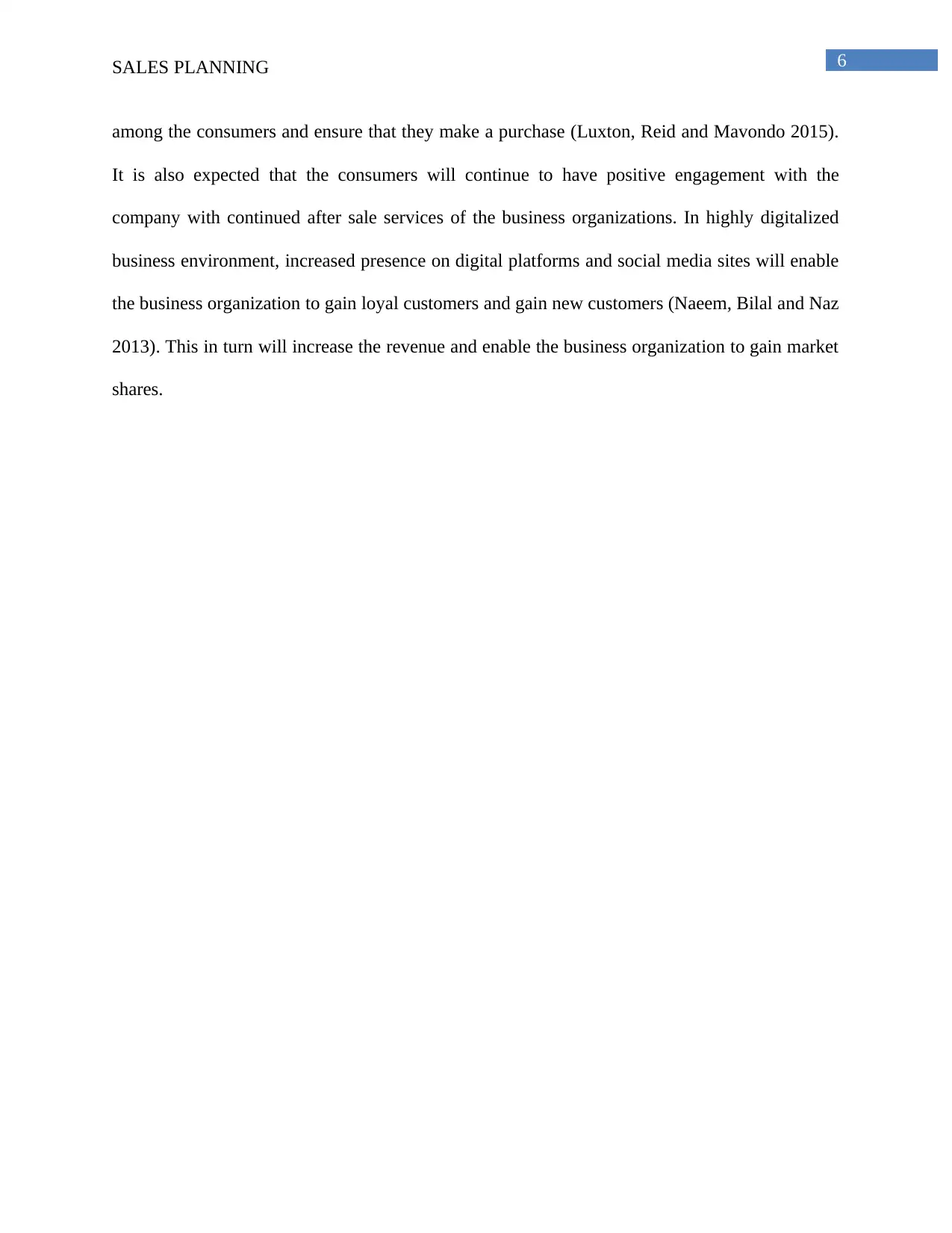
6SALES PLANNING
among the consumers and ensure that they make a purchase (Luxton, Reid and Mavondo 2015).
It is also expected that the consumers will continue to have positive engagement with the
company with continued after sale services of the business organizations. In highly digitalized
business environment, increased presence on digital platforms and social media sites will enable
the business organization to gain loyal customers and gain new customers (Naeem, Bilal and Naz
2013). This in turn will increase the revenue and enable the business organization to gain market
shares.
among the consumers and ensure that they make a purchase (Luxton, Reid and Mavondo 2015).
It is also expected that the consumers will continue to have positive engagement with the
company with continued after sale services of the business organizations. In highly digitalized
business environment, increased presence on digital platforms and social media sites will enable
the business organization to gain loyal customers and gain new customers (Naeem, Bilal and Naz
2013). This in turn will increase the revenue and enable the business organization to gain market
shares.
Paraphrase This Document
Need a fresh take? Get an instant paraphrase of this document with our AI Paraphraser
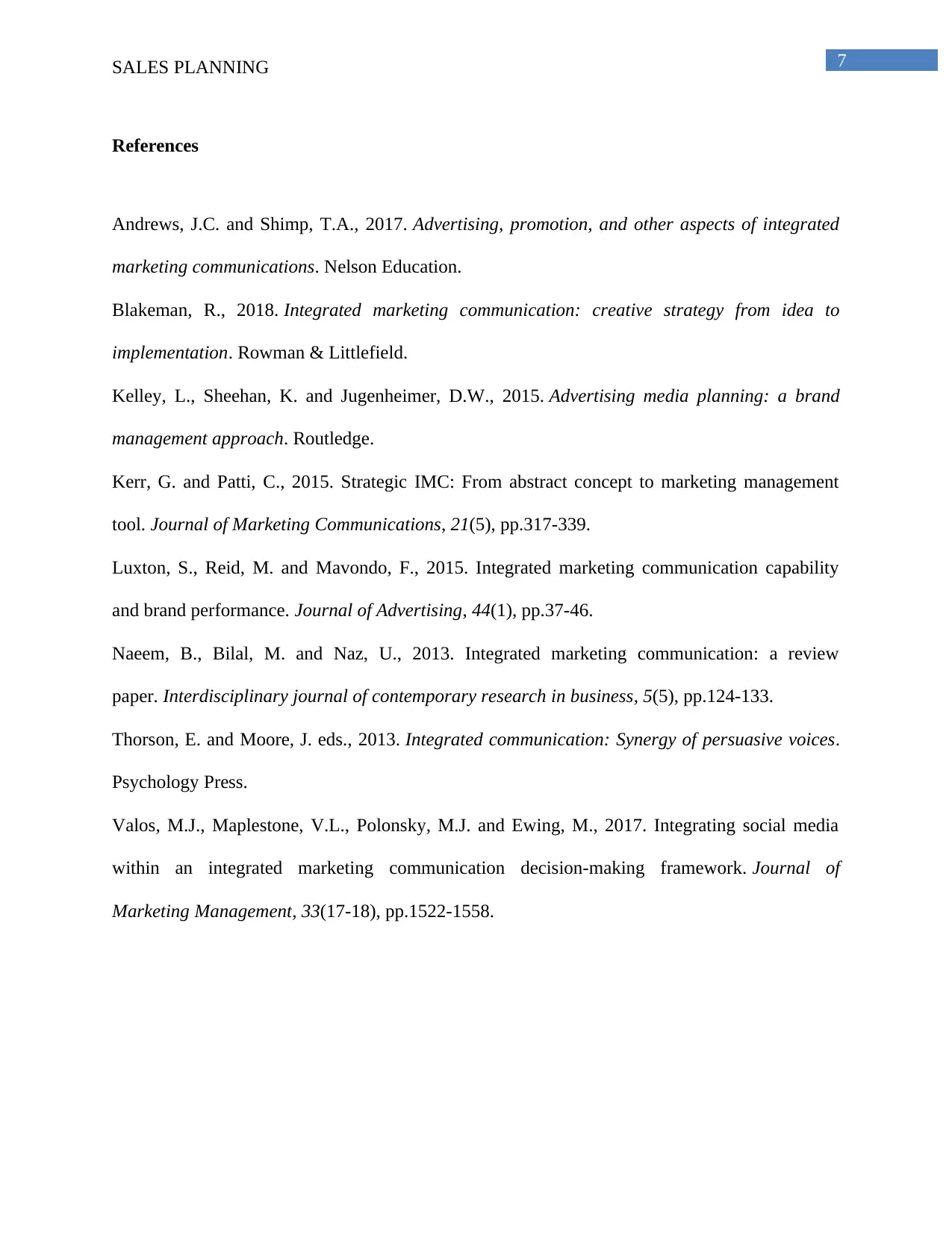
7SALES PLANNING
References
Andrews, J.C. and Shimp, T.A., 2017. Advertising, promotion, and other aspects of integrated
marketing communications. Nelson Education.
Blakeman, R., 2018. Integrated marketing communication: creative strategy from idea to
implementation. Rowman & Littlefield.
Kelley, L., Sheehan, K. and Jugenheimer, D.W., 2015. Advertising media planning: a brand
management approach. Routledge.
Kerr, G. and Patti, C., 2015. Strategic IMC: From abstract concept to marketing management
tool. Journal of Marketing Communications, 21(5), pp.317-339.
Luxton, S., Reid, M. and Mavondo, F., 2015. Integrated marketing communication capability
and brand performance. Journal of Advertising, 44(1), pp.37-46.
Naeem, B., Bilal, M. and Naz, U., 2013. Integrated marketing communication: a review
paper. Interdisciplinary journal of contemporary research in business, 5(5), pp.124-133.
Thorson, E. and Moore, J. eds., 2013. Integrated communication: Synergy of persuasive voices.
Psychology Press.
Valos, M.J., Maplestone, V.L., Polonsky, M.J. and Ewing, M., 2017. Integrating social media
within an integrated marketing communication decision-making framework. Journal of
Marketing Management, 33(17-18), pp.1522-1558.
References
Andrews, J.C. and Shimp, T.A., 2017. Advertising, promotion, and other aspects of integrated
marketing communications. Nelson Education.
Blakeman, R., 2018. Integrated marketing communication: creative strategy from idea to
implementation. Rowman & Littlefield.
Kelley, L., Sheehan, K. and Jugenheimer, D.W., 2015. Advertising media planning: a brand
management approach. Routledge.
Kerr, G. and Patti, C., 2015. Strategic IMC: From abstract concept to marketing management
tool. Journal of Marketing Communications, 21(5), pp.317-339.
Luxton, S., Reid, M. and Mavondo, F., 2015. Integrated marketing communication capability
and brand performance. Journal of Advertising, 44(1), pp.37-46.
Naeem, B., Bilal, M. and Naz, U., 2013. Integrated marketing communication: a review
paper. Interdisciplinary journal of contemporary research in business, 5(5), pp.124-133.
Thorson, E. and Moore, J. eds., 2013. Integrated communication: Synergy of persuasive voices.
Psychology Press.
Valos, M.J., Maplestone, V.L., Polonsky, M.J. and Ewing, M., 2017. Integrating social media
within an integrated marketing communication decision-making framework. Journal of
Marketing Management, 33(17-18), pp.1522-1558.
1 out of 8
Related Documents
Your All-in-One AI-Powered Toolkit for Academic Success.
+13062052269
info@desklib.com
Available 24*7 on WhatsApp / Email
![[object Object]](/_next/static/media/star-bottom.7253800d.svg)
Unlock your academic potential
Copyright © 2020–2025 A2Z Services. All Rights Reserved. Developed and managed by ZUCOL.


